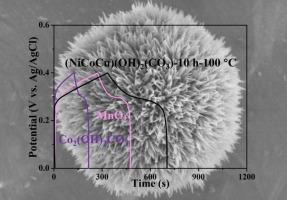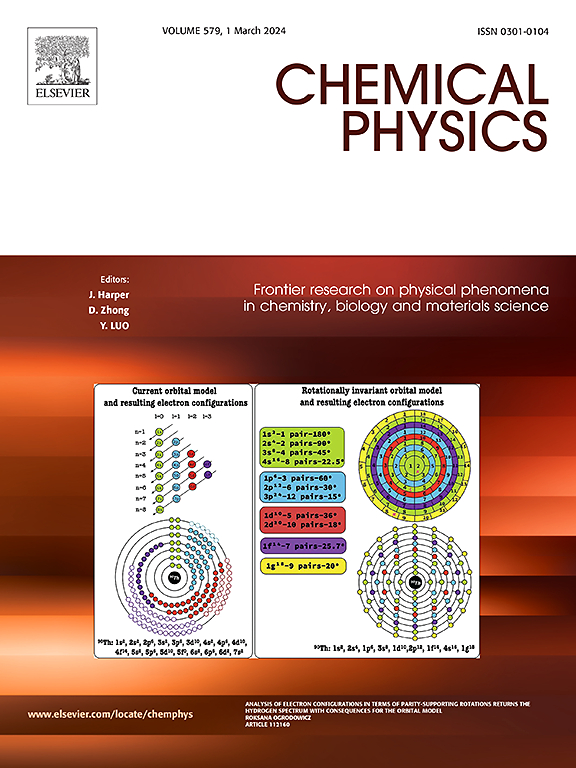Preparation of electrochemical supercapacitor based on fluffy sphere-like NiCoCu-carbonate hydroxide
IF 2
3区 化学
Q4 CHEMISTRY, PHYSICAL
引用次数: 0
Abstract
The NiCoCu-carbonate hydroxides were synthesized via a one-step hydrothermal method at different synthesis times and temperatures ((NiCoCu)(OH)2(CO3)-X-Y, X-hydrothermal time, 5 ∼ 20 h; Y-hydrothermal temperature, 100 ∼ 175 °C). The resulting materials were comprehensively characterized using XRD, FT-IR, XPS, electron microscopy investigation, and electrochemical measurements. These results demonstrate that (NiCoCu)(OH)2(CO3)-X-Y samples exhibit diverse morphologies and possess distinct electrochemical supercapacitor properties. Notably, the comparative analysis reveals that the modified electrode of (NiCoCu)(OH)2(CO3)-10 h-100 °C exhibits superior performance compared to Co2(OH)2CO3 and other prepared samples of (NiCoCu)(OH)2(CO3)-X-Y. It demonstrates a higher specific capacity of 758C/g at 2 A/g and showcases excellent reversible charge/discharge capability, with an approximate retention rate of 80.8 % after undergoing 5000 cycles. It can be concluded that the electrochemical properties of cobalt-based carbonate hydroxides can be greatly improved by incorporating a variety of active metal cations in Co2(OH)2CO3, as the synergistic effect produced by these different active metals plays a significant role.

基于绒毛球状碳酸镍钴合金制备电化学超级电容器
在不同的合成时间和温度下,通过一步水热法合成了镍钴铜碳酸盐氢氧化物((NiCoCu)(OH)2(CO3)-X-Y,X-水热时间,5 ∼ 20 h;Y-水热温度,100 ∼ 175 °C)。利用 XRD、傅立叶变换红外光谱、XPS、电子显微镜研究和电化学测量对所得材料进行了综合表征。这些结果表明,(NiCoCu)(OH)2(CO3)-X-Y 样品呈现出不同的形态,并具有不同的电化学超级电容器特性。值得注意的是,对比分析表明,与 Co2(OH)2CO3 和其他制备的 (NiCoCu)(OH)2(CO3)-X-Y 样品相比,(NiCoCu)(OH)2(CO3)-10 h-100 °C的改性电极表现出更优越的性能。在 2 A/g 条件下,它的比容量高达 758C/g,并具有出色的可逆充放电能力,在经历 5000 次循环后,保持率约为 80.8%。由此可以得出结论,通过在 Co2(OH)2CO3 中加入多种活性金属阳离子,可以大大提高钴基碳酸盐氢氧化物的电化学性能,因为这些不同的活性金属产生的协同效应发挥了重要作用。
本文章由计算机程序翻译,如有差异,请以英文原文为准。
求助全文
约1分钟内获得全文
求助全文
来源期刊

Chemical Physics
化学-物理:原子、分子和化学物理
CiteScore
4.60
自引率
4.30%
发文量
278
审稿时长
39 days
期刊介绍:
Chemical Physics publishes experimental and theoretical papers on all aspects of chemical physics. In this journal, experiments are related to theory, and in turn theoretical papers are related to present or future experiments. Subjects covered include: spectroscopy and molecular structure, interacting systems, relaxation phenomena, biological systems, materials, fundamental problems in molecular reactivity, molecular quantum theory and statistical mechanics. Computational chemistry studies of routine character are not appropriate for this journal.
 求助内容:
求助内容: 应助结果提醒方式:
应助结果提醒方式:


